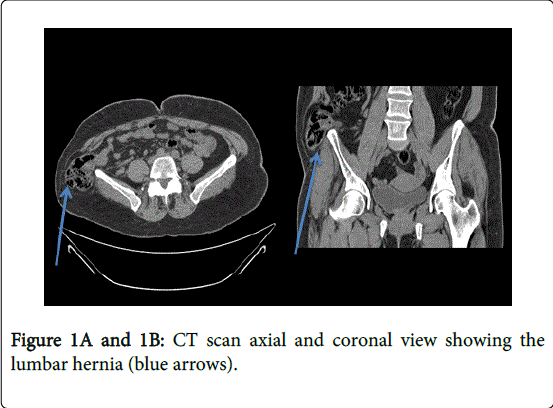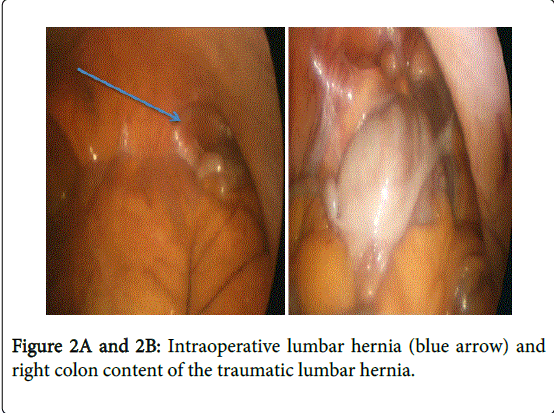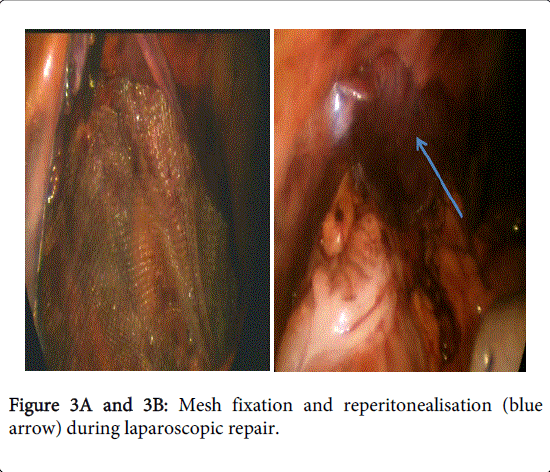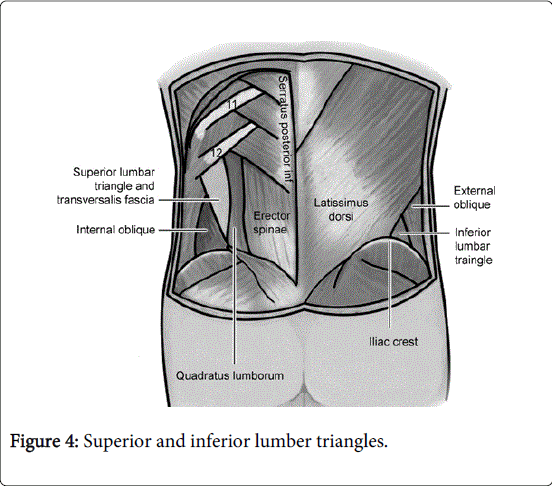Case Report Open Access
Traumatic Lumber Hernia
Yagan Pillay*Department of General Surgery, Victoria Hospital, Prince Albert Parkland Health Region, Prince Albert S6V8C3, SK, Canada
- *Corresponding Author:
- Yagan Pillay
Department of General Surgery
Victoria Hospital, Prince Albert Parkland Health Region
Prince Albert S6V8C3, SK, Canada
Tel: 0013069407245
E-mail: yagan2pillay@yahoo.ca
Received date: June 30, 2015 Accepted date: July 28, 2015 Published date: August 7, 2015
Citation: Pillay Y (2015) Traumatic Lumber Hernia. J Gastrointest Dig Syst 5: 315. doi:10.4172/2161-069X.1000315
Copyright: ©2015 Pillay Y. This is an open-access article distributed under the terms of the Creative Commons Attribution License; which permits unrestricted use; distribution; and reproduction in any medium; provided the original author and source are credited.
Visit for more related articles at Journal of Gastrointestinal & Digestive System
Abstract
Lumbar hernias are a rare type of abdominal wall hernia with fewer than 300 cases reported in the literature over the last 300 years. The aetiology is overwhelmingly due to blunt abdominal trauma such as a motor vehicle collision. It may also arise due to surgery or infection. Surgery remains the mainstay of treatment however the method of repair remains controversial and often provides a challenge for the surgeon. Laparoscopic vs. open repair as well as the type of mesh used (absorbable vs. non absorbable vs. biosynthetic) has not been well elucidated in the current literature.
Abstract
Lumbar hernias are a rare type of abdominal wall hernia with fewer than 300 cases reported in the literature over the last 300 years. The aetiology is overwhelmingly due to blunt abdominal trauma such as a motor vehicle collision. It may also arise due to surgery or infection. Surgery remains the mainstay of treatment however the method of repair remains controversial and often provides a challenge for the surgeon. Laparoscopic vs. open repair as well as the type of mesh used (absorbable vs. non absorbable vs. biosynthetic) has not been well elucidated in the current literature.
Keywords
Lumbar hernia; Laparoscopic mesh repair; Traumatic lumbar hernia
Introduction
Lumbar hernias are an uncommon form of ventral abdominal wall hernias, accounting for less than 1.5% of all abdominal hernias, with fewer than 300 cases reported over the past 300 years. About 25% of all lumbar hernias have a traumatic etiology [1]. This may be post-surgical or following blunt injuries associated with intra-abdominal injuries. Their management often constitutes a surgical challenge.
Case Report
A 55 year old woman presented with right flank pain. There was a history of a motor vehicle collision, seven years previously.
The pain had been increasing over the past month. Clinical examination revealed a swelling in the right flank that was reducible in the supine position. The rest of the abdominal examination was normal.
The swelling had been present for a few years but was now increasing in size. There was no neurological deficit. She did not seek medical attention previously. Her medical history was relevant for bursitis of the right hip joint.
She also smoked a pack of cigarettes a day. Her Computerised Tomography (CT) scan findings showed a traumatic lumbar hernia on the right (Figures 1-4). The risks and alternatives were discussed with the patient and she signed an informed consent for a laparoscopic lumbar hernia repair. Her surgery was uneventful and she made a complete recovery.
Discussion
Lumbar hernia is a rare type of abdominal hernia due to a defect in the posterolateral abdominal wall through which either intraperitoneal or extraperitoneal contents protrude. While the first descriptions of lumbar hernias date to the middle of the 17th century, current medical literature describes approximately 300 cases [2]. The two most common anatomical locations of lumbar hernias are the superior and inferior lumbar triangles, whose boundaries have been well described. The superior triangle, which was first described by Joseph Grynfeltt in 1866, is bordered superiorly by the inferior edge of the 12th rib and the serratus posterior inferior muscle, laterally by the internal oblique, and medially by the quadratus lumborum. In 1783 Jean Louis Petit described the inferior lumbar region as bound by the latissimus dorsi, the free margin of the external oblique, and the superior edge of the iliac crest. The floor of the triangle is composed of lumbodorsal fascia and the transversalis abdominus muscle aponeurosis [3] (Figure 4).
The aetiology of lumbar hernia can be divided into primary and secondary. Primary lumbar hernias comprise 20% and include spontaneous hernias and the lumbocosto vertebral syndrome, in which a congential hernia is associated with rib and vertebral anomalies. Secondary lumbar hernias account for 80% and are associated with trauma, surgery, and infection [4]. The most common etiology for lumbar hernias is blunt abdominal trauma associated with crush injuries or restrained victims of motor vehicle collisions. Burt et al. reviewed 66 cases of lumbar hernias secondary to blunt trauma [5]. They reported 70% of traumatic hernias occurred in the inferior lumbar triangle, 71% were associated with a motor vehicle collision, and 70% of these patients were restrained in the vehicle. 61% had associated intra-abdominal injuries. Burt et al. reported that contents of the lumbar hernia have included fat (42%), colon (41%), and small bowel (32%). On initial presentation 5% were incarcerated. Timing and type of repair had been affected by other associated injuries such as bowel perforation or delay in diagnosis.
The first transabdominal laparoscopic approach was introduced by Burick and Parascandola [6]. The balloon dissector was used in 1999 for a total extraperitoneal approach by Woodward et al. [7] Moreno-Egea et al. has shown statistically significant lower morbidity rates, shorter length of hospital stay, reduced analgesic requirement and an earlier return to normal activity in the laparoscopic repair group [8]. Synthetic mesh for hernia repair has the complications of infection, bowel obstruction and fistula formation. Recently the use of biosynthetic mesh made of human acellular dermis has been used with good results especially in contaminated wounds [9].
References
- Sharma P (2009) Lumbar Hernia. Med Journal of Armed Forces of India(MJAFI): Vol 64: 2009.
- Moreno-Egea A, Baena EG, Calle MC, Martínez JA, Albasini JL (2007) Controversies in the current management of lumbar hernias.Arch Surg 142: 82-88.
- Orcutt TW (1971) Hernia of the superior lumbar triangle.Ann Surg 173: 294-297.
- Loukas M, Tubbs RS, Shoja M (2008) Lumbar hernia, anatomical basis and clinical aspects.SurgRadiolAnat 30: 609-610.
- Burt BM, Afifi HY, Wantz GE, Barie PS (2004) Traumatic lumbar hernia: report of cases and comprehensive review of the literature.J Trauma 57: 1361-1370.
- Burick AJ,Parascandola SA (1996) Laparoscopic repair of a traumatic lumbar hernia: a case report.J LaparoendoscSurg 6: 259-262.
- Woodward AM, Flint LM, Ferrara JJ (1999) Laparoscopic retroperitoneal repair of recurrent postoperative lumbar hernia.J LaparoendoscAdvSurg Tech A 9: 181-186.
- Moreno-Egea A, Torralba-Martinez JA, Morales G, Fernández T, Girela E, et al. (2005) Open vs. laparoscopic repair of secondary lumbar hernias: a prospective nonrandomized study.SurgEndosc 19: 184-187.
- Beth-Ann S, Victoriya Sara C, Kelly J, Joshua NH, Tomer D (2012) Repair of a traumatic lumbar hernia with biosynthetic mesh:a novel approach and review of the literature. J CurrSurg 2:105-109.
Relevant Topics
- Constipation
- Digestive Enzymes
- Endoscopy
- Epigastric Pain
- Gall Bladder
- Gastric Cancer
- Gastrointestinal Bleeding
- Gastrointestinal Hormones
- Gastrointestinal Infections
- Gastrointestinal Inflammation
- Gastrointestinal Pathology
- Gastrointestinal Pharmacology
- Gastrointestinal Radiology
- Gastrointestinal Surgery
- Gastrointestinal Tuberculosis
- GIST Sarcoma
- Intestinal Blockage
- Pancreas
- Salivary Glands
- Stomach Bloating
- Stomach Cramps
- Stomach Disorders
- Stomach Ulcer
Recommended Journals
Article Tools
Article Usage
- Total views: 14660
- [From(publication date):
August-2015 - Jul 18, 2024] - Breakdown by view type
- HTML page views : 10325
- PDF downloads : 4335




